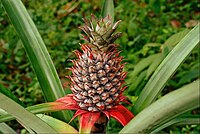
Photo from wikipedia
A novel bacterial strain of acetic acid bacteria capable of producing riboflavin was isolated from the soil sample collected in Wuhan, China. The isolated strain was identified as Gluconobacter oxydans… Click to show full abstract
A novel bacterial strain of acetic acid bacteria capable of producing riboflavin was isolated from the soil sample collected in Wuhan, China. The isolated strain was identified as Gluconobacter oxydans FBFS97 based on several phenotype characteristics, biochemicals tests, and 16S rRNA gene sequence conducted. Furthermore, the complete genome sequencing of the isolated strain has showed that it contains a complete operon for the biosynthesis of riboflavin. In order to obtain the maximum concentration of riboflavin production, Gluconobacter oxydans FBFS97 was optimized in shake flask cultures through response surface methodology employing Plackett–Burman design (PBD), and Central composite design (CCD). The results of the pre-experiments displayed that fructose and tryptone were found to be the most suitable sources of carbon and nitrogen for riboflavin production. Then, PBD was conducted for initial screening of eleven minerals (FeSO4, FeCl3, KH2PO4, K2HPO4, MgSO4, ZnSO4, NaCl, CaCl2, KCl, ZnCl2, and AlCl3.6H2O) for their significances on riboflavin production by Gluconobacter oxydans strain FBFS97. The most significant variables affecting on riboflavin production are K2HPO4 and CaCl2, the interaction affects and levels of these variables were optimized by CCD. After optimization of the medium compositions for riboflavin production were determined as follows: fructose 25 g/L, tryptone 12.5 g/L, K2HPO4 9 g/L, and CaCl2 0.06 g/L with maximum riboflavin production 23.24 mg/L.
Journal Title: Scientific Reports
Year Published: 2020
Link to full text (if available)
Share on Social Media: Sign Up to like & get
recommendations!